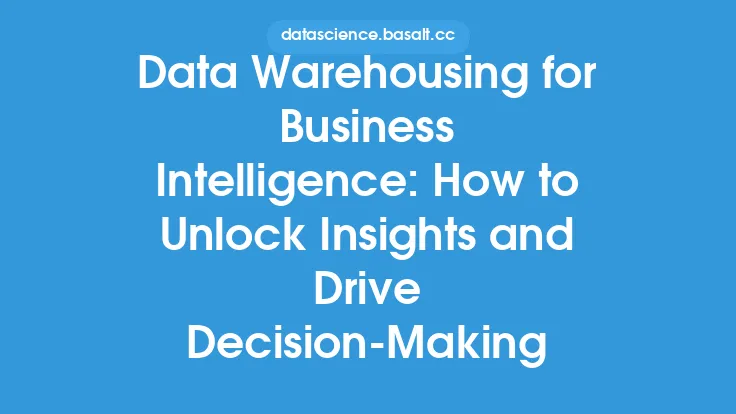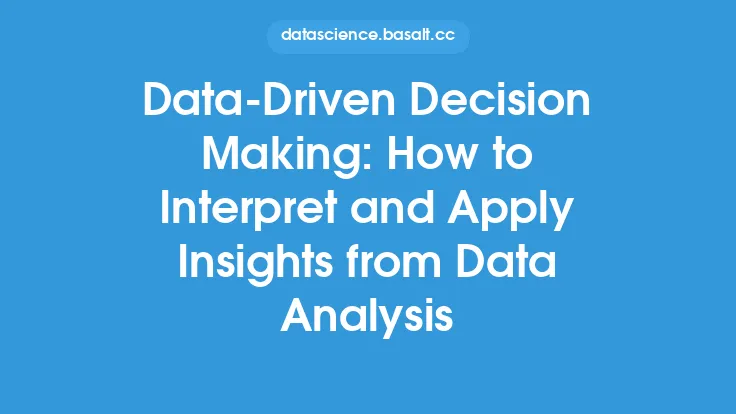Data completeness is a critical aspect of data quality that plays a significant role in business decision-making. In today's data-driven world, organizations rely heavily on data to inform their decisions, drive business growth, and stay competitive. However, incomplete or missing data can lead to inaccurate insights, poor decision-making, and ultimately, negative consequences for the business. In this article, we will explore the relationship between data completeness and business decision-making, and why it is essential for organizations to prioritize data completeness.
Introduction to Data Completeness
Data completeness refers to the extent to which a dataset contains all the required information to support business decisions. It involves ensuring that all relevant data elements are present, accurate, and up-to-date. Data completeness is a critical component of data quality, as it directly impacts the reliability and accuracy of insights generated from the data. Incomplete data can lead to biased or incorrect conclusions, which can have far-reaching consequences for businesses.
The Impact of Data Completeness on Business Decision-Making
Data completeness has a significant impact on business decision-making. When data is complete, accurate, and reliable, organizations can make informed decisions with confidence. Complete data provides a comprehensive understanding of the business, enabling decision-makers to identify trends, patterns, and opportunities. On the other hand, incomplete data can lead to poor decision-making, as it may not provide a accurate representation of the business. Incomplete data can result in missed opportunities, incorrect resource allocation, and poor strategic decisions.
The Consequences of Incomplete Data
The consequences of incomplete data can be severe and far-reaching. Incomplete data can lead to incorrect insights, which can result in poor decision-making. For example, if a company is analyzing customer data to inform marketing strategies, incomplete data may lead to incorrect conclusions about customer behavior, preferences, and demographics. This can result in ineffective marketing campaigns, wasted resources, and lost revenue. Additionally, incomplete data can also lead to compliance issues, as regulatory bodies require organizations to maintain accurate and complete records.
The Role of Data Governance in Ensuring Data Completeness
Data governance plays a critical role in ensuring data completeness. Data governance involves establishing policies, procedures, and standards to ensure that data is accurate, complete, and reliable. It involves defining data quality metrics, establishing data validation rules, and implementing data monitoring and reporting processes. Effective data governance ensures that data is complete, accurate, and consistent across the organization, enabling decision-makers to rely on the data to inform their decisions.
Technical Aspects of Data Completeness
From a technical perspective, data completeness involves ensuring that all required data elements are present in the dataset. This involves defining data quality rules, such as data validation and data normalization, to ensure that data is accurate and consistent. Additionally, data completeness also involves ensuring that data is properly formatted and standardized, to enable seamless integration and analysis. Technical aspects of data completeness also involve implementing data profiling and data monitoring tools, to identify and address data quality issues.
Data Completeness in Different Business Functions
Data completeness is critical in various business functions, including marketing, sales, finance, and operations. In marketing, complete data is essential for understanding customer behavior, preferences, and demographics. In sales, complete data is necessary for identifying sales opportunities, tracking customer interactions, and analyzing sales performance. In finance, complete data is required for financial reporting, budgeting, and forecasting. In operations, complete data is necessary for supply chain management, inventory management, and logistics.
Best Practices for Achieving Data Completeness
Achieving data completeness requires a combination of people, processes, and technology. Best practices for achieving data completeness include establishing clear data quality metrics, defining data governance policies, and implementing data validation and data normalization rules. Additionally, organizations should also implement data monitoring and reporting processes, to identify and address data quality issues. Furthermore, organizations should also provide training and education to employees, to ensure that they understand the importance of data completeness and how to maintain it.
Conclusion
In conclusion, data completeness is a critical aspect of data quality that plays a significant role in business decision-making. Complete data provides a comprehensive understanding of the business, enabling decision-makers to identify trends, patterns, and opportunities. Incomplete data, on the other hand, can lead to poor decision-making, missed opportunities, and negative consequences for the business. By prioritizing data completeness, organizations can ensure that their decisions are informed, accurate, and reliable. By implementing data governance policies, defining data quality metrics, and using technical tools and techniques, organizations can achieve data completeness and drive business success.





